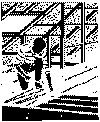|
12
QUESTIONS TO
Ask About an Attic ...
Professional home
inspectors ask questions very similar to these when inspecting
attics.
|
1. Is
the attic insulated
adequately and
properly?
Ten to
twelve inches is
adequate in most
situations.
2.
Does existing insulation
contain a
vapor barrier?
Vapor
barriers should
always face the
heated side of a
ceiling or wall.
3. Is
there proper and clear
ventilation?
High-low
ventilation is the
most desirable and the more insulation,
the more beneficial it is.
4. Does
the attic fan or power ventilator
work?
These items
may not be necessary, and
adequate ventilation is more important,
but if they are present they
should operate properly. A safety shroud
or some type of screening should
protect a homeís occupants from
fan blades.
5. Is
there delaminating plywood or warped
roofing boards?
Causes may
be expansion of plywood, condensation,
or poor workmanship.
6.
Are there signs, especially around the chimney
and plumbing vent stacks, of
past or current roof leakage?
Seventy
percent of roof leaks occur at flashings
and valleys.
|
7. Are
air-conditioning and
heating ducts
insulated?
Ductwork
in attics loses
a significant amount
of its effectiveness
due to extreme
summer and
winter temperatures.
8.
Are there open joint in
the ductwork?
Air
losses may negatively
impact cooling
and heating
efficiency.

9. Do any plumbing vent stacks terminate
in the attic?
The
vents will function, but they must
vent above the roof to expel
sewer odors.
10.
Are exhaust fans from the kitchen or
bathrooms
discharging into the attic?
They
will add moisture to the attic and
may cause
condensation concerns.
11.
Are there open electrical junction
boxes
or improperly terminated electrical
wiring?
The
electric fixtures may function properly,
but there may be a safety
issue.
12.
Are there any cracked, broken, or
sagging sections of rafters or truss
members?
Reinforcement
may not be urgent,
but it is necessary. |
|
So
next time you are listing a home for sale, advise your
clients that these are the types of questions
that home inspectors will ask when inspecting that home for
purchase.
Page
2 |
|
From
the desk of . . .
Arthur
S. Lazerow
SYNTHETIC STUCCO
If the house
is historic, itís
probably
listed in this site
with photos, drawings, and
histories. If not, check out the
second site for tips
and links
wondered about
that whole-house fan
you say? The following guidelines
should
be followed when installing
or using a
whole-house fan:
. Use
it only when the
outside air is not
higher in
temperature than the interior
space being ventilated.
.
Open only the windows where
ventilation is presently
needed: the
living
room during the cooler
evening
hours, the
bedroom at night, or
the
kitchen/breakfast area early in
the morning.
. Do
not use
the whole-house exhaust
fan in conjunction with a heating or
cooling system, or
while a fireplace
is
burning.
. Consider
building a safety
grille
around the exposed fan
mechanism in
the attic to
help prevent accidental
injury from rotating blades and other
moving parts.
Home On The
Web
Beware! Synthetic stucco, known as
Exterior
Insulating
Finish System (EIFS),
is experiencing
water intrusion problems in many
areas around the country.
This product is an
exterior cladding product,
designed to shed
weather, while adding a Mediterranean
look
to the
home. It is much different from
masonry
stucco cladding.
True stucco is a masonry
sub-surface with a
three-quarter to one
inch
application of mortar that was
then often
painted.
EIFS is a one-eighth inch
of coating over
fiberglass
mesh placed on
styrofoam board.
Stress on the styrofoam,
penetrations of utility
lines, joints at windows and
doors or at
roof/wall junctions are areas
permitting water
penetration. Purchasers of home with
EIFS type exterior
cladding should be aware of
the potential for water intrusion
problems, with
resulting interior damage and
possible mold
growth. Lightly tapping on an
exterior wall
will help identify masonry or
styrofoam
board
backing. Fortunately
there is a warranty program
protecting purchasers
ó the Moisture
Free
Warranty. It
is a three- or five-year
warranty with
up
to $150,000 in
protection and a $30,000 annual
limit. An initial
inspection must be made
by a certified EIFS inspector and every 18
months during the warranty, a reinspection
is made without cost to the homeowner. More
information is available at www.moisturewarranty.com
or call -800-
400-8679.

|